Legal Analysis: Marina Salo's Defamation Claim - Qld Corruption Files
VerifiedAdded on 2023/02/01
|11
|2908
|96
Report
AI Summary
This legal memorandum, prepared by a junior associate, analyzes a defamation claim on behalf of Marina Salo against AAmazing Webhosting (AW) and Patrick Holtz. The memo addresses the elements of defamation, including defamatory matter, publication, and identification of the plaintiff. It examines defamatory imputations, distinguishing between false and true innuendo, and assesses whether Salo can establish a successful claim. The memorandum then explores statutory defenses such as honest opinion and innocent dissemination, evaluating their applicability to Holtz and AW. Finally, it discusses available remedies, including damages, injunctions, and offers to make amends, providing a summary of advice to the senior partner regarding the case's prospects and recommendations on forcing AW to remove the defamatory article from their website. The analysis is based on relevant legal principles and case law.

Topic: Defamation
Tort Law-Defamation
Student name
College/affiliation
LEGAL MEMORANDUM
Tort Law-Defamation
Student name
College/affiliation
LEGAL MEMORANDUM
Paraphrase This Document
Need a fresh take? Get an instant paraphrase of this document with our AI Paraphraser
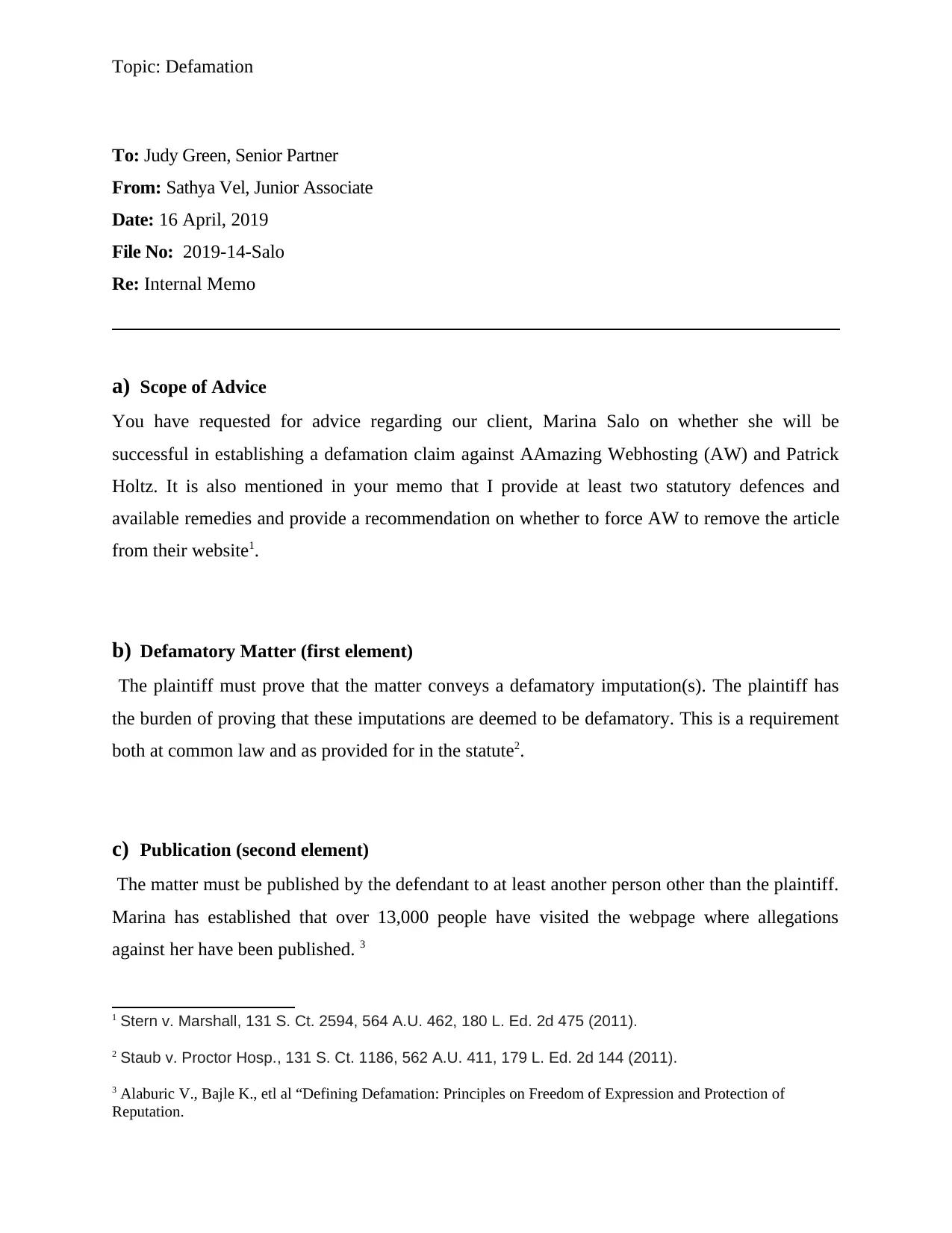
Topic: Defamation
To: Judy Green, Senior Partner
From: Sathya Vel, Junior Associate
Date: 16 April, 2019
File No: 2019-14-Salo
Re: Internal Memo
a) Scope of Advice
You have requested for advice regarding our client, Marina Salo on whether she will be
successful in establishing a defamation claim against AAmazing Webhosting (AW) and Patrick
Holtz. It is also mentioned in your memo that I provide at least two statutory defences and
available remedies and provide a recommendation on whether to force AW to remove the article
from their website1.
b) Defamatory Matter (first element)
The plaintiff must prove that the matter conveys a defamatory imputation(s). The plaintiff has
the burden of proving that these imputations are deemed to be defamatory. This is a requirement
both at common law and as provided for in the statute2.
c) Publication (second element)
The matter must be published by the defendant to at least another person other than the plaintiff.
Marina has established that over 13,000 people have visited the webpage where allegations
against her have been published. 3
1 Stern v. Marshall, 131 S. Ct. 2594, 564 A.U. 462, 180 L. Ed. 2d 475 (2011).
2 Staub v. Proctor Hosp., 131 S. Ct. 1186, 562 A.U. 411, 179 L. Ed. 2d 144 (2011).
3 Alaburic V., Bajle K., etl al “Defining Defamation: Principles on Freedom of Expression and Protection of
Reputation.
To: Judy Green, Senior Partner
From: Sathya Vel, Junior Associate
Date: 16 April, 2019
File No: 2019-14-Salo
Re: Internal Memo
a) Scope of Advice
You have requested for advice regarding our client, Marina Salo on whether she will be
successful in establishing a defamation claim against AAmazing Webhosting (AW) and Patrick
Holtz. It is also mentioned in your memo that I provide at least two statutory defences and
available remedies and provide a recommendation on whether to force AW to remove the article
from their website1.
b) Defamatory Matter (first element)
The plaintiff must prove that the matter conveys a defamatory imputation(s). The plaintiff has
the burden of proving that these imputations are deemed to be defamatory. This is a requirement
both at common law and as provided for in the statute2.
c) Publication (second element)
The matter must be published by the defendant to at least another person other than the plaintiff.
Marina has established that over 13,000 people have visited the webpage where allegations
against her have been published. 3
1 Stern v. Marshall, 131 S. Ct. 2594, 564 A.U. 462, 180 L. Ed. 2d 475 (2011).
2 Staub v. Proctor Hosp., 131 S. Ct. 1186, 562 A.U. 411, 179 L. Ed. 2d 144 (2011).
3 Alaburic V., Bajle K., etl al “Defining Defamation: Principles on Freedom of Expression and Protection of
Reputation.
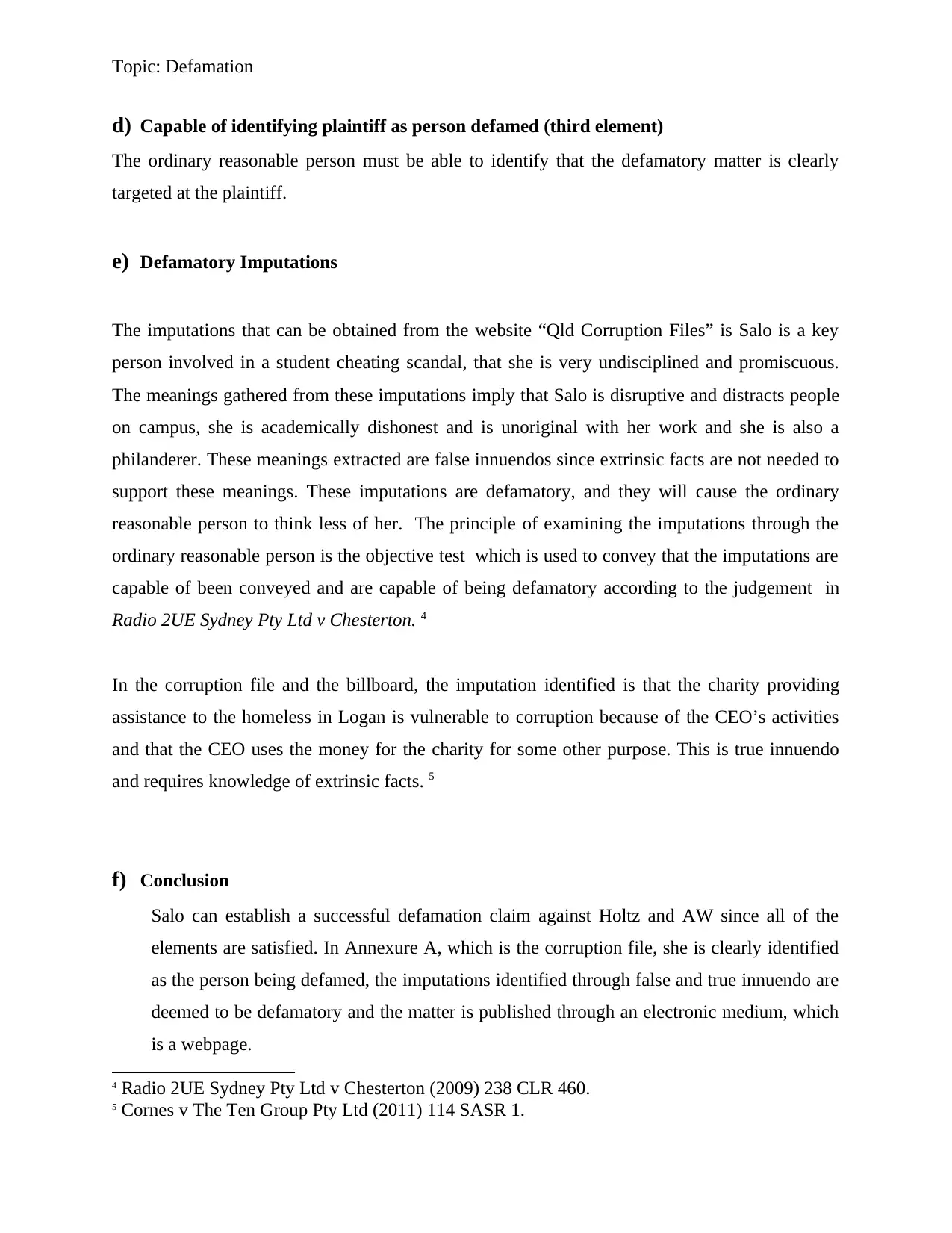
Topic: Defamation
d) Capable of identifying plaintiff as person defamed (third element)
The ordinary reasonable person must be able to identify that the defamatory matter is clearly
targeted at the plaintiff.
e) Defamatory Imputations
The imputations that can be obtained from the website “Qld Corruption Files” is Salo is a key
person involved in a student cheating scandal, that she is very undisciplined and promiscuous.
The meanings gathered from these imputations imply that Salo is disruptive and distracts people
on campus, she is academically dishonest and is unoriginal with her work and she is also a
philanderer. These meanings extracted are false innuendos since extrinsic facts are not needed to
support these meanings. These imputations are defamatory, and they will cause the ordinary
reasonable person to think less of her. The principle of examining the imputations through the
ordinary reasonable person is the objective test which is used to convey that the imputations are
capable of been conveyed and are capable of being defamatory according to the judgement in
Radio 2UE Sydney Pty Ltd v Chesterton. 4
In the corruption file and the billboard, the imputation identified is that the charity providing
assistance to the homeless in Logan is vulnerable to corruption because of the CEO’s activities
and that the CEO uses the money for the charity for some other purpose. This is true innuendo
and requires knowledge of extrinsic facts. 5
f) Conclusion
Salo can establish a successful defamation claim against Holtz and AW since all of the
elements are satisfied. In Annexure A, which is the corruption file, she is clearly identified
as the person being defamed, the imputations identified through false and true innuendo are
deemed to be defamatory and the matter is published through an electronic medium, which
is a webpage.
4 Radio 2UE Sydney Pty Ltd v Chesterton (2009) 238 CLR 460.
5 Cornes v The Ten Group Pty Ltd (2011) 114 SASR 1.
d) Capable of identifying plaintiff as person defamed (third element)
The ordinary reasonable person must be able to identify that the defamatory matter is clearly
targeted at the plaintiff.
e) Defamatory Imputations
The imputations that can be obtained from the website “Qld Corruption Files” is Salo is a key
person involved in a student cheating scandal, that she is very undisciplined and promiscuous.
The meanings gathered from these imputations imply that Salo is disruptive and distracts people
on campus, she is academically dishonest and is unoriginal with her work and she is also a
philanderer. These meanings extracted are false innuendos since extrinsic facts are not needed to
support these meanings. These imputations are defamatory, and they will cause the ordinary
reasonable person to think less of her. The principle of examining the imputations through the
ordinary reasonable person is the objective test which is used to convey that the imputations are
capable of been conveyed and are capable of being defamatory according to the judgement in
Radio 2UE Sydney Pty Ltd v Chesterton. 4
In the corruption file and the billboard, the imputation identified is that the charity providing
assistance to the homeless in Logan is vulnerable to corruption because of the CEO’s activities
and that the CEO uses the money for the charity for some other purpose. This is true innuendo
and requires knowledge of extrinsic facts. 5
f) Conclusion
Salo can establish a successful defamation claim against Holtz and AW since all of the
elements are satisfied. In Annexure A, which is the corruption file, she is clearly identified
as the person being defamed, the imputations identified through false and true innuendo are
deemed to be defamatory and the matter is published through an electronic medium, which
is a webpage.
4 Radio 2UE Sydney Pty Ltd v Chesterton (2009) 238 CLR 460.
5 Cornes v The Ten Group Pty Ltd (2011) 114 SASR 1.
⊘ This is a preview!⊘
Do you want full access?
Subscribe today to unlock all pages.

Trusted by 1+ million students worldwide

Topic: Defamation
g) Statutory Defences
i) Honest Opinion
The defence of honest opinion can be used if these three elements are satisfied:
(1) the defendant must prove that the matter is an expression of his or her opinion rather than a
statement of fact.
(2) The opinion of the matter is related to public interest.
(3) The opinion of the defendant is based on proper material. Proper material is defined as
material that is (a) substantially true; or (b) published on the occasion of qualified or absolute
privilege; or (c) the matter was published on an occasion in which there is the protection of a
defence under this section or section 28 and 29.6
In this instance, Holtz cannot claim that whatever he said was an honest opinion. This is so since,
he had indicated to Marina that he will payback no matter the period. Also, the massage he left
marine the revenge he had against her. Therefore, since there is evidence of malicious, the
defence of honest opinion cannot be relied on be Holtz. 7
ii) Defence of innocent dissemination
(1) It is a defence to the publication of defamatory matter if the defendant proves that—
(a) the defendant published the matter merely in the capacity, or as an employee or agent, of a
subordinate distributor8; and
6 Defamation Act 2005 (Qld) s 31(1).
7Kenyon Andrew, “Six Years of Australian Uniform Defamation Law: Damages, Opinion and
Defence Meanings.
8 Kiobel v. Royal Dutch Petroleum Co., 133 S. Ct. 1659, 569 A.U. 108, 185 L. Ed. 2d 671 (2013).
g) Statutory Defences
i) Honest Opinion
The defence of honest opinion can be used if these three elements are satisfied:
(1) the defendant must prove that the matter is an expression of his or her opinion rather than a
statement of fact.
(2) The opinion of the matter is related to public interest.
(3) The opinion of the defendant is based on proper material. Proper material is defined as
material that is (a) substantially true; or (b) published on the occasion of qualified or absolute
privilege; or (c) the matter was published on an occasion in which there is the protection of a
defence under this section or section 28 and 29.6
In this instance, Holtz cannot claim that whatever he said was an honest opinion. This is so since,
he had indicated to Marina that he will payback no matter the period. Also, the massage he left
marine the revenge he had against her. Therefore, since there is evidence of malicious, the
defence of honest opinion cannot be relied on be Holtz. 7
ii) Defence of innocent dissemination
(1) It is a defence to the publication of defamatory matter if the defendant proves that—
(a) the defendant published the matter merely in the capacity, or as an employee or agent, of a
subordinate distributor8; and
6 Defamation Act 2005 (Qld) s 31(1).
7Kenyon Andrew, “Six Years of Australian Uniform Defamation Law: Damages, Opinion and
Defence Meanings.
8 Kiobel v. Royal Dutch Petroleum Co., 133 S. Ct. 1659, 569 A.U. 108, 185 L. Ed. 2d 671 (2013).
Paraphrase This Document
Need a fresh take? Get an instant paraphrase of this document with our AI Paraphraser
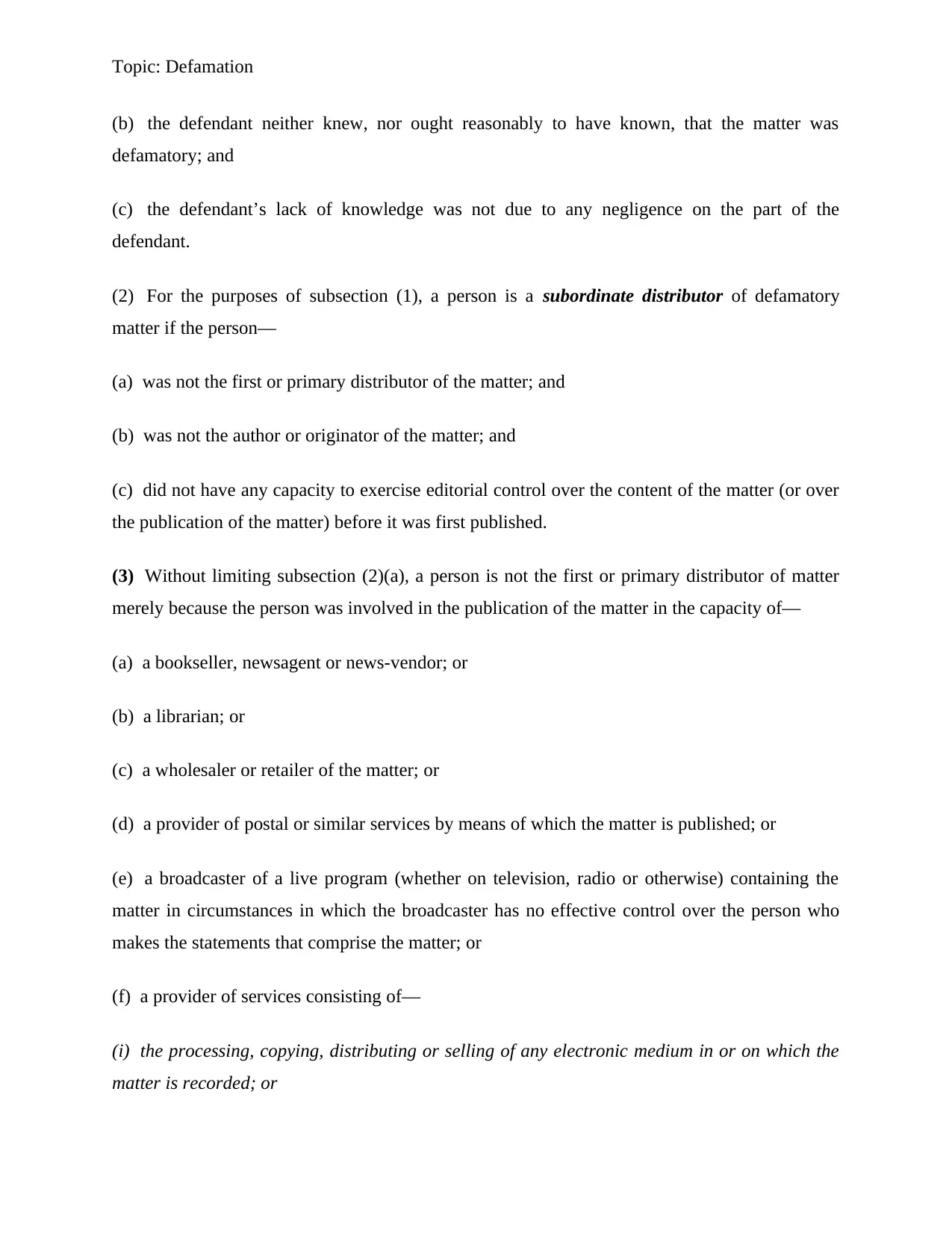
Topic: Defamation
(b) the defendant neither knew, nor ought reasonably to have known, that the matter was
defamatory; and
(c) the defendant’s lack of knowledge was not due to any negligence on the part of the
defendant.
(2) For the purposes of subsection (1), a person is a subordinate distributor of defamatory
matter if the person—
(a) was not the first or primary distributor of the matter; and
(b) was not the author or originator of the matter; and
(c) did not have any capacity to exercise editorial control over the content of the matter (or over
the publication of the matter) before it was first published.
(3) Without limiting subsection (2)(a), a person is not the first or primary distributor of matter
merely because the person was involved in the publication of the matter in the capacity of—
(a) a bookseller, newsagent or news-vendor; or
(b) a librarian; or
(c) a wholesaler or retailer of the matter; or
(d) a provider of postal or similar services by means of which the matter is published; or
(e) a broadcaster of a live program (whether on television, radio or otherwise) containing the
matter in circumstances in which the broadcaster has no effective control over the person who
makes the statements that comprise the matter; or
(f) a provider of services consisting of—
(i) the processing, copying, distributing or selling of any electronic medium in or on which the
matter is recorded; or
(b) the defendant neither knew, nor ought reasonably to have known, that the matter was
defamatory; and
(c) the defendant’s lack of knowledge was not due to any negligence on the part of the
defendant.
(2) For the purposes of subsection (1), a person is a subordinate distributor of defamatory
matter if the person—
(a) was not the first or primary distributor of the matter; and
(b) was not the author or originator of the matter; and
(c) did not have any capacity to exercise editorial control over the content of the matter (or over
the publication of the matter) before it was first published.
(3) Without limiting subsection (2)(a), a person is not the first or primary distributor of matter
merely because the person was involved in the publication of the matter in the capacity of—
(a) a bookseller, newsagent or news-vendor; or
(b) a librarian; or
(c) a wholesaler or retailer of the matter; or
(d) a provider of postal or similar services by means of which the matter is published; or
(e) a broadcaster of a live program (whether on television, radio or otherwise) containing the
matter in circumstances in which the broadcaster has no effective control over the person who
makes the statements that comprise the matter; or
(f) a provider of services consisting of—
(i) the processing, copying, distributing or selling of any electronic medium in or on which the
matter is recorded; or
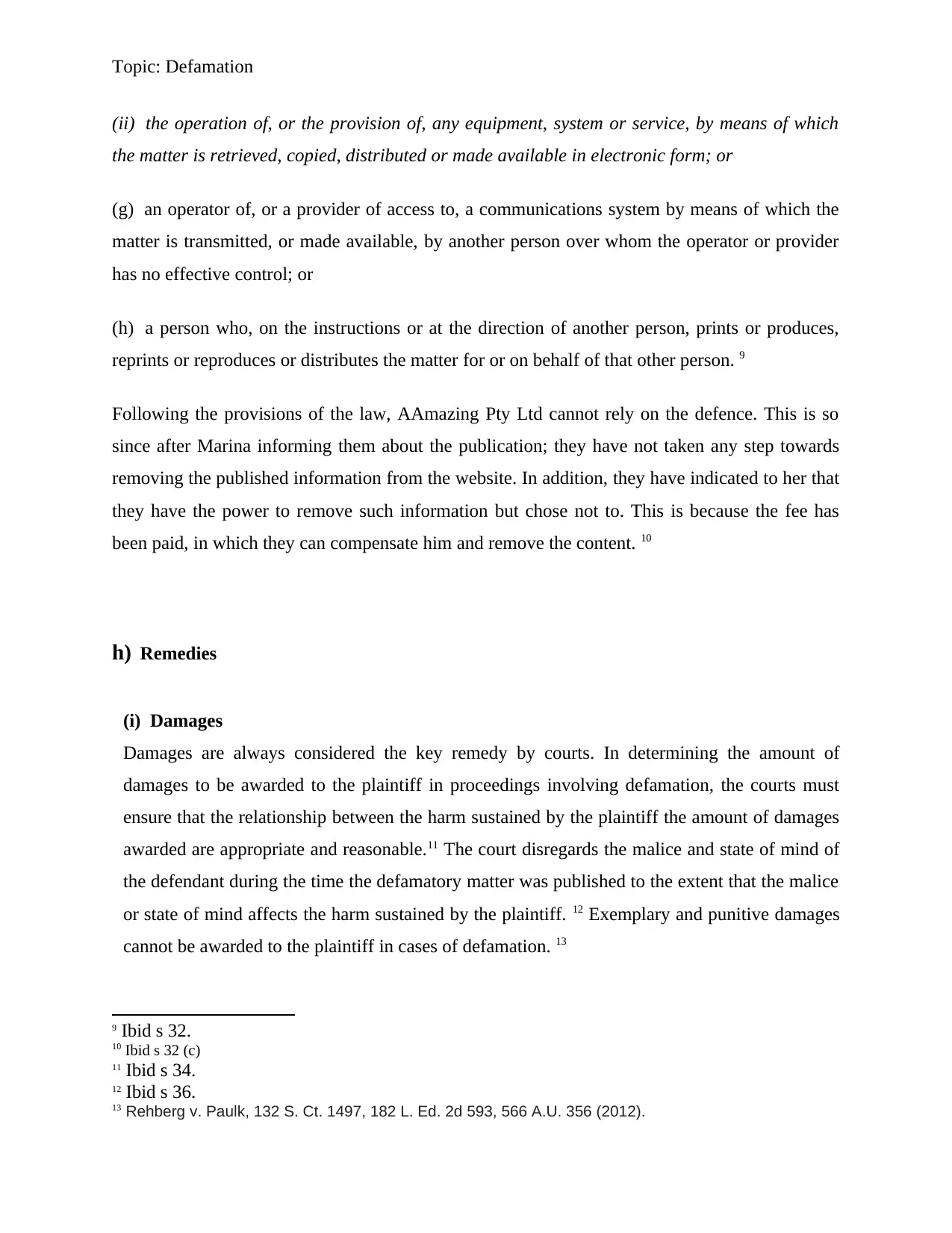
Topic: Defamation
(ii) the operation of, or the provision of, any equipment, system or service, by means of which
the matter is retrieved, copied, distributed or made available in electronic form; or
(g) an operator of, or a provider of access to, a communications system by means of which the
matter is transmitted, or made available, by another person over whom the operator or provider
has no effective control; or
(h) a person who, on the instructions or at the direction of another person, prints or produces,
reprints or reproduces or distributes the matter for or on behalf of that other person. 9
Following the provisions of the law, AAmazing Pty Ltd cannot rely on the defence. This is so
since after Marina informing them about the publication; they have not taken any step towards
removing the published information from the website. In addition, they have indicated to her that
they have the power to remove such information but chose not to. This is because the fee has
been paid, in which they can compensate him and remove the content. 10
h) Remedies
(i) Damages
Damages are always considered the key remedy by courts. In determining the amount of
damages to be awarded to the plaintiff in proceedings involving defamation, the courts must
ensure that the relationship between the harm sustained by the plaintiff the amount of damages
awarded are appropriate and reasonable.11 The court disregards the malice and state of mind of
the defendant during the time the defamatory matter was published to the extent that the malice
or state of mind affects the harm sustained by the plaintiff. 12 Exemplary and punitive damages
cannot be awarded to the plaintiff in cases of defamation. 13
9 Ibid s 32.
10 Ibid s 32 (c)
11 Ibid s 34.
12 Ibid s 36.
13 Rehberg v. Paulk, 132 S. Ct. 1497, 182 L. Ed. 2d 593, 566 A.U. 356 (2012).
(ii) the operation of, or the provision of, any equipment, system or service, by means of which
the matter is retrieved, copied, distributed or made available in electronic form; or
(g) an operator of, or a provider of access to, a communications system by means of which the
matter is transmitted, or made available, by another person over whom the operator or provider
has no effective control; or
(h) a person who, on the instructions or at the direction of another person, prints or produces,
reprints or reproduces or distributes the matter for or on behalf of that other person. 9
Following the provisions of the law, AAmazing Pty Ltd cannot rely on the defence. This is so
since after Marina informing them about the publication; they have not taken any step towards
removing the published information from the website. In addition, they have indicated to her that
they have the power to remove such information but chose not to. This is because the fee has
been paid, in which they can compensate him and remove the content. 10
h) Remedies
(i) Damages
Damages are always considered the key remedy by courts. In determining the amount of
damages to be awarded to the plaintiff in proceedings involving defamation, the courts must
ensure that the relationship between the harm sustained by the plaintiff the amount of damages
awarded are appropriate and reasonable.11 The court disregards the malice and state of mind of
the defendant during the time the defamatory matter was published to the extent that the malice
or state of mind affects the harm sustained by the plaintiff. 12 Exemplary and punitive damages
cannot be awarded to the plaintiff in cases of defamation. 13
9 Ibid s 32.
10 Ibid s 32 (c)
11 Ibid s 34.
12 Ibid s 36.
13 Rehberg v. Paulk, 132 S. Ct. 1497, 182 L. Ed. 2d 593, 566 A.U. 356 (2012).
⊘ This is a preview!⊘
Do you want full access?
Subscribe today to unlock all pages.

Trusted by 1+ million students worldwide
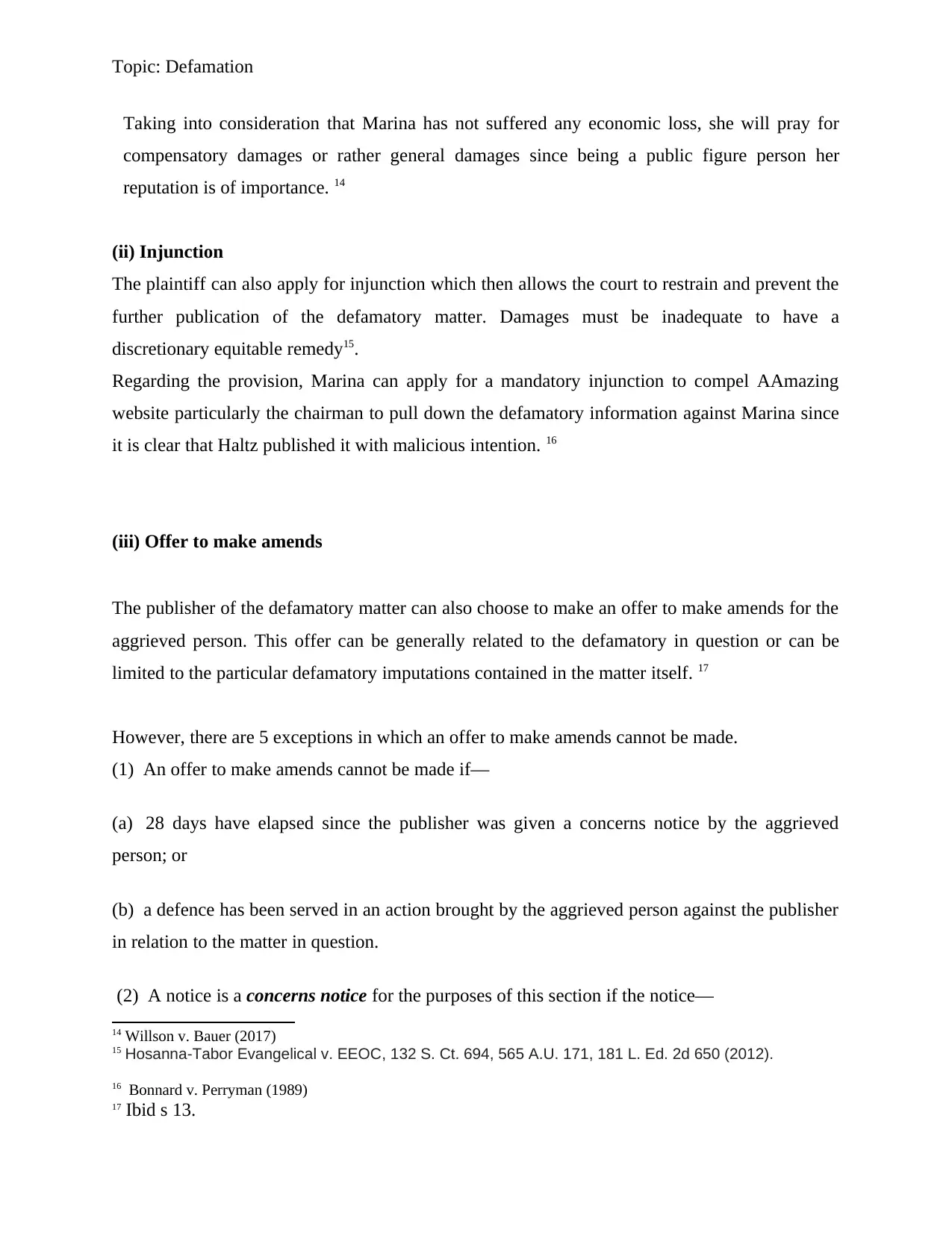
Topic: Defamation
Taking into consideration that Marina has not suffered any economic loss, she will pray for
compensatory damages or rather general damages since being a public figure person her
reputation is of importance. 14
(ii) Injunction
The plaintiff can also apply for injunction which then allows the court to restrain and prevent the
further publication of the defamatory matter. Damages must be inadequate to have a
discretionary equitable remedy15.
Regarding the provision, Marina can apply for a mandatory injunction to compel AAmazing
website particularly the chairman to pull down the defamatory information against Marina since
it is clear that Haltz published it with malicious intention. 16
(iii) Offer to make amends
The publisher of the defamatory matter can also choose to make an offer to make amends for the
aggrieved person. This offer can be generally related to the defamatory in question or can be
limited to the particular defamatory imputations contained in the matter itself. 17
However, there are 5 exceptions in which an offer to make amends cannot be made.
(1) An offer to make amends cannot be made if—
(a) 28 days have elapsed since the publisher was given a concerns notice by the aggrieved
person; or
(b) a defence has been served in an action brought by the aggrieved person against the publisher
in relation to the matter in question.
(2) A notice is a concerns notice for the purposes of this section if the notice—
14 Willson v. Bauer (2017)
15 Hosanna-Tabor Evangelical v. EEOC, 132 S. Ct. 694, 565 A.U. 171, 181 L. Ed. 2d 650 (2012).
16 Bonnard v. Perryman (1989)
17 Ibid s 13.
Taking into consideration that Marina has not suffered any economic loss, she will pray for
compensatory damages or rather general damages since being a public figure person her
reputation is of importance. 14
(ii) Injunction
The plaintiff can also apply for injunction which then allows the court to restrain and prevent the
further publication of the defamatory matter. Damages must be inadequate to have a
discretionary equitable remedy15.
Regarding the provision, Marina can apply for a mandatory injunction to compel AAmazing
website particularly the chairman to pull down the defamatory information against Marina since
it is clear that Haltz published it with malicious intention. 16
(iii) Offer to make amends
The publisher of the defamatory matter can also choose to make an offer to make amends for the
aggrieved person. This offer can be generally related to the defamatory in question or can be
limited to the particular defamatory imputations contained in the matter itself. 17
However, there are 5 exceptions in which an offer to make amends cannot be made.
(1) An offer to make amends cannot be made if—
(a) 28 days have elapsed since the publisher was given a concerns notice by the aggrieved
person; or
(b) a defence has been served in an action brought by the aggrieved person against the publisher
in relation to the matter in question.
(2) A notice is a concerns notice for the purposes of this section if the notice—
14 Willson v. Bauer (2017)
15 Hosanna-Tabor Evangelical v. EEOC, 132 S. Ct. 694, 565 A.U. 171, 181 L. Ed. 2d 650 (2012).
16 Bonnard v. Perryman (1989)
17 Ibid s 13.
Paraphrase This Document
Need a fresh take? Get an instant paraphrase of this document with our AI Paraphraser

Topic: Defamation
(a) is in writing; and
(b) informs the publisher of the defamatory imputations that the aggrieved person considers are
or may be carried about the aggrieved person by the matter in question (the imputations of
concern).
(3) If an aggrieved person gives the publisher a concerns notice, but fails to particularise the
imputations of concern adequately, the publisher may give the aggrieved person a written notice
(a further particulars notice) requesting the aggrieved person to provide reasonable further
particulars about the imputations of concern as specified in the further particulars notice.
(4) An aggrieved person to whom a further particulars notice is given must provide the
reasonable further particulars specified in the notice within 14 days (or any further period agreed
by the publisher and aggrieved person) after being given the notice.
(5) An aggrieved person who fails to provide the reasonable further particulars specified in a
further particulars notice within the applicable period is taken not to have given the publisher a
concerns notice for the purposes of this section. 18
As the facts of the case are presented, Haltz and AAmazing Webhosting stand a chance to make
the offer since the time specified within such an offer is to be made has not yet lapsed. Further,
since the defence has not been served they still stand a chance offer amends.19
Summary of Advice
Marina can successfully carry out an action of defamation since of the elements are satisfied. On
the other hand, she must be aware of the defences available to the defendants, Holtz and AW.
18 Ibid s 14.
19 Bausch v. Stryker Corp., 630 F.3d 546 (7th Cir. 2010).
(a) is in writing; and
(b) informs the publisher of the defamatory imputations that the aggrieved person considers are
or may be carried about the aggrieved person by the matter in question (the imputations of
concern).
(3) If an aggrieved person gives the publisher a concerns notice, but fails to particularise the
imputations of concern adequately, the publisher may give the aggrieved person a written notice
(a further particulars notice) requesting the aggrieved person to provide reasonable further
particulars about the imputations of concern as specified in the further particulars notice.
(4) An aggrieved person to whom a further particulars notice is given must provide the
reasonable further particulars specified in the notice within 14 days (or any further period agreed
by the publisher and aggrieved person) after being given the notice.
(5) An aggrieved person who fails to provide the reasonable further particulars specified in a
further particulars notice within the applicable period is taken not to have given the publisher a
concerns notice for the purposes of this section. 18
As the facts of the case are presented, Haltz and AAmazing Webhosting stand a chance to make
the offer since the time specified within such an offer is to be made has not yet lapsed. Further,
since the defence has not been served they still stand a chance offer amends.19
Summary of Advice
Marina can successfully carry out an action of defamation since of the elements are satisfied. On
the other hand, she must be aware of the defences available to the defendants, Holtz and AW.
18 Ibid s 14.
19 Bausch v. Stryker Corp., 630 F.3d 546 (7th Cir. 2010).
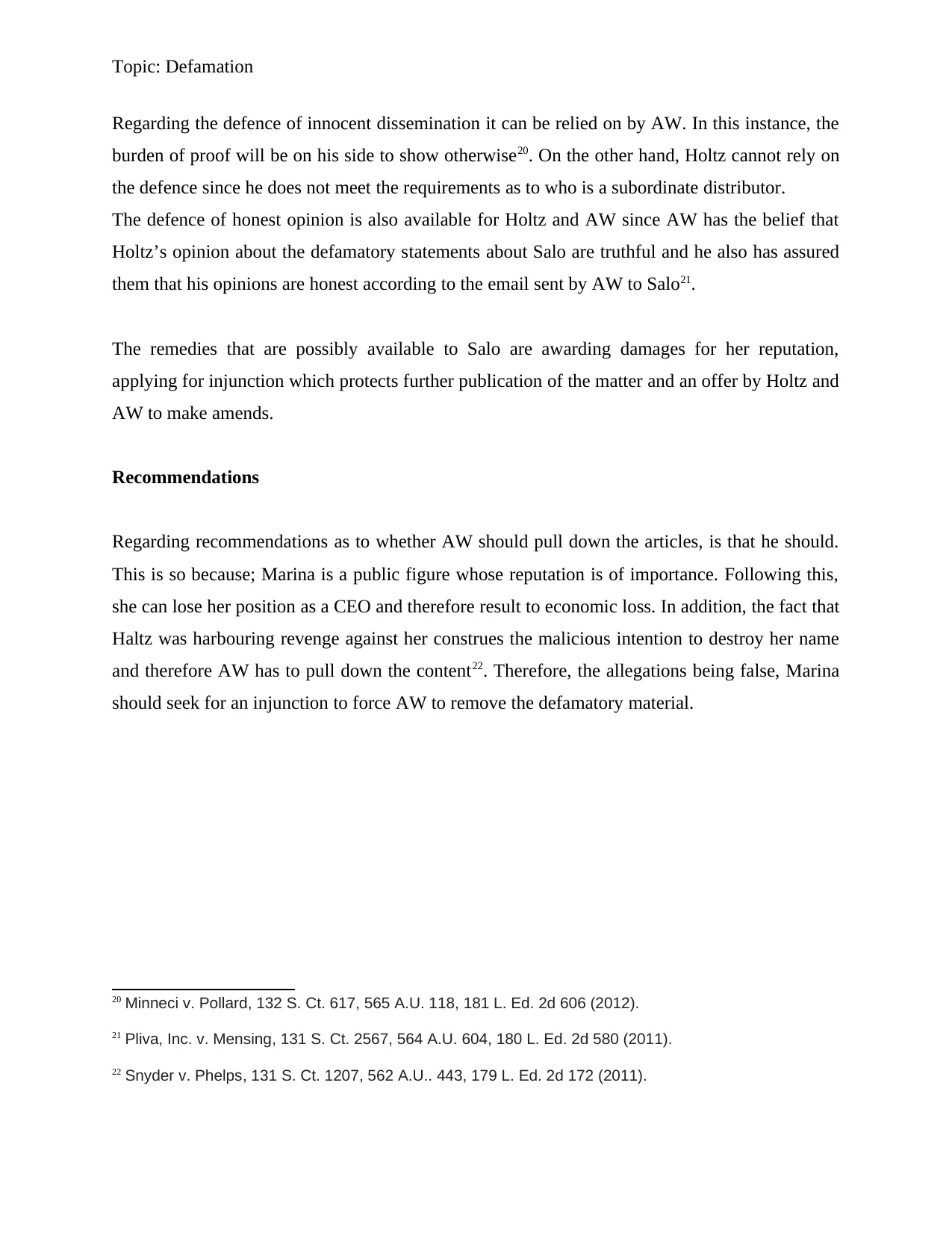
Topic: Defamation
Regarding the defence of innocent dissemination it can be relied on by AW. In this instance, the
burden of proof will be on his side to show otherwise20. On the other hand, Holtz cannot rely on
the defence since he does not meet the requirements as to who is a subordinate distributor.
The defence of honest opinion is also available for Holtz and AW since AW has the belief that
Holtz’s opinion about the defamatory statements about Salo are truthful and he also has assured
them that his opinions are honest according to the email sent by AW to Salo21.
The remedies that are possibly available to Salo are awarding damages for her reputation,
applying for injunction which protects further publication of the matter and an offer by Holtz and
AW to make amends.
Recommendations
Regarding recommendations as to whether AW should pull down the articles, is that he should.
This is so because; Marina is a public figure whose reputation is of importance. Following this,
she can lose her position as a CEO and therefore result to economic loss. In addition, the fact that
Haltz was harbouring revenge against her construes the malicious intention to destroy her name
and therefore AW has to pull down the content22. Therefore, the allegations being false, Marina
should seek for an injunction to force AW to remove the defamatory material.
20 Minneci v. Pollard, 132 S. Ct. 617, 565 A.U. 118, 181 L. Ed. 2d 606 (2012).
21 Pliva, Inc. v. Mensing, 131 S. Ct. 2567, 564 A.U. 604, 180 L. Ed. 2d 580 (2011).
22 Snyder v. Phelps, 131 S. Ct. 1207, 562 A.U.. 443, 179 L. Ed. 2d 172 (2011).
Regarding the defence of innocent dissemination it can be relied on by AW. In this instance, the
burden of proof will be on his side to show otherwise20. On the other hand, Holtz cannot rely on
the defence since he does not meet the requirements as to who is a subordinate distributor.
The defence of honest opinion is also available for Holtz and AW since AW has the belief that
Holtz’s opinion about the defamatory statements about Salo are truthful and he also has assured
them that his opinions are honest according to the email sent by AW to Salo21.
The remedies that are possibly available to Salo are awarding damages for her reputation,
applying for injunction which protects further publication of the matter and an offer by Holtz and
AW to make amends.
Recommendations
Regarding recommendations as to whether AW should pull down the articles, is that he should.
This is so because; Marina is a public figure whose reputation is of importance. Following this,
she can lose her position as a CEO and therefore result to economic loss. In addition, the fact that
Haltz was harbouring revenge against her construes the malicious intention to destroy her name
and therefore AW has to pull down the content22. Therefore, the allegations being false, Marina
should seek for an injunction to force AW to remove the defamatory material.
20 Minneci v. Pollard, 132 S. Ct. 617, 565 A.U. 118, 181 L. Ed. 2d 606 (2012).
21 Pliva, Inc. v. Mensing, 131 S. Ct. 2567, 564 A.U. 604, 180 L. Ed. 2d 580 (2011).
22 Snyder v. Phelps, 131 S. Ct. 1207, 562 A.U.. 443, 179 L. Ed. 2d 172 (2011).
⊘ This is a preview!⊘
Do you want full access?
Subscribe today to unlock all pages.

Trusted by 1+ million students worldwide

Topic: Defamation
Paraphrase This Document
Need a fresh take? Get an instant paraphrase of this document with our AI Paraphraser

Topic: Defamation
Bibliography
Journal articles
Alaburic V., Bajle K., etl al “Defining Defamation: Principles on Freedom of Expression and
Protection of Reputation (2002)
Kenyon Andrew, “Six Years of Australian Uniform Defamation Law: Damages, Opinion and
Defence Meanings.
Case Laws
Radio 2UE Sydney Pty Ltd v Chesterton (2009) 238 CLR 460
Cornes v The Ten Group Pty Ltd (2011) 114 SASR 1
Willson v. Bauer (2017)
Bonnard v. Perryman (1989) 2 Ch 269)
Minneci v. Pollard, 132 S. Ct. 617, 565 A.U. 118, 181 L. Ed. 2d 606 (2012).
Pliva, Inc. v. Mensing, 131 S. Ct. 2567, 564 A.U. 604, 180 L. Ed. 2d 580 (2011).
Kiobel v. Royal Dutch Petroleum Co., 133 S. Ct. 1659, 569 A.U. 108, 185 L. Ed. 2d 671 (2013).
Stern v. Marshall, 131 S. Ct. 2594, 564 A.U. 462, 180 L. Ed. 2d 475 (2011).
Staub v. Proctor Hosp., 131 S. Ct. 1186, 562 A.U. 411, 179 L. Ed. 2d 144 (2011).
Snyder v. Phelps, 131 S. Ct. 1207, 562 A.U.. 443, 179 L. Ed. 2d 172 (2011).
Bausch v. Stryker Corp., 630 F.3d 546 (7th Cir. 2010).
Rehberg v. Paulk, 132 S. Ct. 1497, 182 L. Ed. 2d 593, 566 A.U. 356 (2012).
Hosanna-Tabor Evangelical v. EEOC, 132 S. Ct. 694, 565 A.U. 171, 181 L. Ed. 2d 650 (2012).
Legislation
Defamation Act 2005 (Qld Act)
Bibliography
Journal articles
Alaburic V., Bajle K., etl al “Defining Defamation: Principles on Freedom of Expression and
Protection of Reputation (2002)
Kenyon Andrew, “Six Years of Australian Uniform Defamation Law: Damages, Opinion and
Defence Meanings.
Case Laws
Radio 2UE Sydney Pty Ltd v Chesterton (2009) 238 CLR 460
Cornes v The Ten Group Pty Ltd (2011) 114 SASR 1
Willson v. Bauer (2017)
Bonnard v. Perryman (1989) 2 Ch 269)
Minneci v. Pollard, 132 S. Ct. 617, 565 A.U. 118, 181 L. Ed. 2d 606 (2012).
Pliva, Inc. v. Mensing, 131 S. Ct. 2567, 564 A.U. 604, 180 L. Ed. 2d 580 (2011).
Kiobel v. Royal Dutch Petroleum Co., 133 S. Ct. 1659, 569 A.U. 108, 185 L. Ed. 2d 671 (2013).
Stern v. Marshall, 131 S. Ct. 2594, 564 A.U. 462, 180 L. Ed. 2d 475 (2011).
Staub v. Proctor Hosp., 131 S. Ct. 1186, 562 A.U. 411, 179 L. Ed. 2d 144 (2011).
Snyder v. Phelps, 131 S. Ct. 1207, 562 A.U.. 443, 179 L. Ed. 2d 172 (2011).
Bausch v. Stryker Corp., 630 F.3d 546 (7th Cir. 2010).
Rehberg v. Paulk, 132 S. Ct. 1497, 182 L. Ed. 2d 593, 566 A.U. 356 (2012).
Hosanna-Tabor Evangelical v. EEOC, 132 S. Ct. 694, 565 A.U. 171, 181 L. Ed. 2d 650 (2012).
Legislation
Defamation Act 2005 (Qld Act)
1 out of 11
Your All-in-One AI-Powered Toolkit for Academic Success.
+13062052269
info@desklib.com
Available 24*7 on WhatsApp / Email
![[object Object]](/_next/static/media/star-bottom.7253800d.svg)
Unlock your academic potential
Copyright © 2020–2025 A2Z Services. All Rights Reserved. Developed and managed by ZUCOL.
